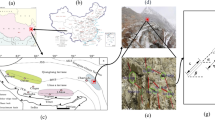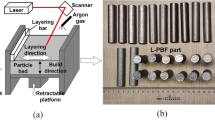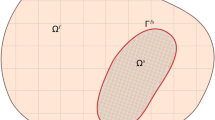Abstract
The study of the evolution of solid fragmentation during high-pressure water jet impact is essential for the control and optimization of high-pressure water jet technology. Smoothed particle hydrodynamics (SPH) method has unique advantages in dealing with such fluid–solid coupling problems due to its meshless and Lagrangian characteristics. Therefore, based on the improved SPH method, this paper simulates the high-pressure water jet impacting the metal and concrete material problems. The results show that, when the water jet impacts the metal block, the penetration depth increases with the increase in the jet velocity, showing an approximately linear relationship. When the water jet impacts the concrete containing initial cracks, the concrete fragmentation zone evolution process is divided into different stages. At the same time, an approximately linear relationship can be observed between the crater depth and jet velocity. When the water jet impacts the homogeneous concrete, the concrete fragmentation goes through the stages of crater formation, conical crack formation, vertical crack formation, and laminar crack formation. Similarly, the crater depth increases with the jet velocity, and the crater depth of homogeneous concrete is smaller compared to that of concrete with initial cracks.














Similar content being viewed by others

References
Yang, Z.Q., Dou, L.M., Liu, C., Xu, M.T., Lei, Z., Yao, Y.H.: Application of high-pressure water jet technology and the theory of rock burst control in roadway. Int. J. Min. Sci. Technol. 26(5), 929–935 (2016). https://doi.org/10.1016/j.ijmst.2016.05.037
Ge, Z.L., Zhang, H.W., Zhou, Z., Cao, S.R., Zhang, D., Liu, X.J., Tian, C.: Experimental study on the characteristics and mechanism of high-pressure water jet fracturing in high-temperature hard rocks. Energy 270, 126848 (2023). https://doi.org/10.1016/j.energy.2023.126848
Jiang, H.X., Zhao, H.H., Gao, K.D., Wang, O.G., Wang, Y.X., Meng, D.G.: Numerical investigation of hard rock breakage by high-pressure water jet assisted indenter impact using the coupled SPH/FEM method. Powder Technol. 376, 176–186 (2020). https://doi.org/10.1016/j.powtec.2020.08.028
Jaya, H.S., Wardana, I.N.G., Hamidi, N., et al.: Hydrolysis reaction utilizing cavitation from high pressure water jet impinging into palm oil bath. Ain Shams Eng. J. 12(4), 3905–3918 (2021). https://doi.org/10.1016/j.asej.2021.03.023
Bowden, F.P., Field, J.E.: The brittle fracture of solids by liquid impact, by solid impact, and by shock. Proc. R. Soc. A-Math. Phys. 1964, 331–352 (1964). https://doi.org/10.1098/rspa.1964.0236
Ni, H.J., Wang, R.H., Zhang, Y.Q.: A damage model for rock under high pressure water jet. Eng. Mech. 20(5), 59–62 (2003)
Li, G.S., Liao, H.L., Huang, Z.W., et al.: Rock damage mechanisms under ultrahigh pressure water Jet Impact. J. Eng. Mech. 45(10), 284–293 (2009). https://doi.org/10.3901/JME.2009.10.284
Yang, Y.Y., Li, G.S.: Experimental study on rock breaking and cutting by ultra-high pressure water jet. J. Univ. Pet. 1, 36–37 (2003)
Wang, F., Wang, R., Zhou, W., et al.: Numerical simulation and experimental verification of the rock damage field under particle water jet impacting. Int. J. Impact Eng 102, 169–179 (2017). https://doi.org/10.1016/j.ijimpeng.2016.12.019
Liu, X., Tang, P., Geng, Q., et al.: Effect of abrasive concentration on impact performance of abrasive water jet crushing concrete. Shock. Vib. 1, 3285150 (2019). https://doi.org/10.1155/2019/3285150
Junkar, M., Jureisevic, B., Fajdiga, M., et al.: Finite element analysis of single-particle impact in abrasive water jet machining. Int. J. Impact Eng 32, 1095–1112 (2006). https://doi.org/10.1016/j.ijimpeng.2004.09.006
Mabrouki, T., Raissi, K., Cornier, A.: Numerical simulation and experimental study of the interaction between a pure high-velocity waterjet and targets: contribution to investigate the decoating process. Wear 239, 260–273 (2000). https://doi.org/10.1016/S0043-1648(00)00333-1
Zhang, X., Lu, M.W., Wang, J.J.: Research progress in arbitrary Lagrangian–Eulerian method. Chin. J. Comput. Mech. 1, 93–104 (1997)
Xu, F., Wang, J., Yang, Y., et al.: On methodology and application of smoothed particle hydrodynamics in fluid, solid and biomechanics. Acta Mech. Sinica-Prc 39, 722185 (2023). https://doi.org/10.1007/s10409-022-22185-x
Khayyer, A., Gotoh, H., Falahaty, H., et al.: An enhanced ISPH–SPH coupled method for simulation of incompressible fluid–elastic structure interactions. Comput. Phys. Commun. 232, 139–164 (2018). https://doi.org/10.1016/j.cpc.2018.05.012
Khayyer, A., Shimizu, Y., Gotoh, H., et al.: A 3D SPH-based entirely Lagrangian meshfree hydroelastic FSI solver for anisotropic composite structures. Appl. Math. Model. 112, 560–613 (2022). https://doi.org/10.1016/j.apm.2022.07.031
Zhang, X., Shi, Y., Pan, G., et al.: Study on the impact performance of sandwich hollow cylinders hitting water based on SPH method. Ocean Eng. 197, 106808 (2020). https://doi.org/10.1016/j.oceaneng.2019.106808
Dyka, C.T., Randles, P.W., Ingel, R.P.: Stress points for tension instability in SPH. Int J Numer Methods Eng 40, 2325–2341 (1997). https://doi.org/10.1002/(SICI)1097-0207(19970715)40:13%3c2325::AID-NME161%3e3.0.CO;2-8
Monaghan, J.J.: SPH without a tensile instability. J. Comput. Phys. 159(2), 290–311 (2000). https://doi.org/10.1006/jcph.2000.6439
Belytschko, T., Xiao, S.: Stability analysis of particle methods with corrected derivatives. Comput. Math. Appl. 43, 329–350 (2002). https://doi.org/10.1016/S0898-1221(01)00290-5
Islam, M.R.I., Peng, C.: A total Lagrangian SPH method for modelling damage and failure in solids. Int. J. Mech. Sci. 157, 498–511 (2019). https://doi.org/10.1016/j.ijmecsci.2019.05.003
Colagrossi, A., Landrini, M.: Numerical simulation of interfacial flows by smoothed particle hydrodynamics. J. Comput. Phys. 191(2), 448–475 (2003). https://doi.org/10.1016/S0021-9991(03)00324-3
Zhang, C., Hu, X.Y., Adams, N.A.: A weakly compressible SPH method based on a low dissipation Riemann solver. J. Comput. Phys. 335, 605–620 (2017). https://doi.org/10.1016/j.jcp.2017.01.027
Wang, L., Xu, F., Yang, Y.: Improvement of the tensile instability in SPH scheme for the FEI (Fluid-Elastomer Interaction) problem. Eng. Anal. Bound. Elements 106, 116–125 (2019). https://doi.org/10.1016/j.enganabound.2019.04.032
Han, L., Hu, X.: SPH modeling of fluid structure interaction. J. Hydrodyn. 30(1), 62–69 (2018). https://doi.org/10.1007/s42241-018-0006-9
Monaghan, J.J.: Smoothed Particle Hydrodynamics and Its Diverse Applications. Annu. Rev. Fluid Mech. 44, 323–346 (2012). https://doi.org/10.1146/annurev-fluid-120710-101220
Liu, M.B., Liu, G.R.: Restoring particle consistency in smoothed particle hydrodynamics. Appl. Numer. Math. 56(1), 19–36 (2006). https://doi.org/10.1016/j.apnum.2005.02.012
Wang, L., Xu, F., Yang, Y.: An improved total Lagrangian SPH method for modeling solid deformation and damage. Eng Anal Bound Elem 133(1), 286–302 (2021). https://doi.org/10.1016/j.enganabound.2021.09.010
Hassan, O.I., Ghavamian, A., Lee, C.H.: An upwind vertex centred finite volume algorithm for nearly and truly incompressible explicit fast solid dynamic applications: Total and Updated Lagrangian formulations. J. Comput. Phys.: X 3, 100025 (2019). https://doi.org/10.1016/j.jcpx.2019.100025
Adami, S., Hu, X.Y., Adams, N.A.: A generalized wall boundary condition for smoothed particle hydrodynamics. J. Comput. Phys. 231(21), 7057–7075 (2012). https://doi.org/10.1016/j.jcp.2012.05.005
Wang, L., Xu, F., Yang, Y.: Research on water entry problems of gas-structure-liquid coupling based on SPH method. Ocean Eng. 257, 111623 (2022). https://doi.org/10.1016/j.oceaneng.2022.111623
Ma, L., Bao, R., Guo, Y.: Waterjet penetration simulation by hybrid code of SPH and FEA. Int. J. Impact Eng 35, 1035–1042 (2008). https://doi.org/10.1016/j.ijimpeng.2007.05.007
Liu, J., Zhang, D., Du, S., et al.: Crack formation mechanism of concrete with an initial crack under hydraulic impacting. J. Vib. Shock 39(14), 130–135 (2020)
Momber, A.W., Wong, Y.C., Budidharma, E., et al.: Surface profiling of low carbon steel with supersonic waterjets. Wear 249, 853–859 (2001). https://doi.org/10.1016/S0043-1648(01)00699-8
Zhang D (2019) Study on Fracturing Characteristics and Mechanism of High-Pressure Water Jet Impacting Concrete. Dissertation, Chongqing Jiaotong University
Acknowledgements
This work was supported by the Natural Science Basic Research Program of Shaanxi Province (2023-JC-QN-0022), the Fundamental Research Funds for the Central Universities (CHD, No. 300102282105), the Key Laboratory of Liquid Rocket Engine Technology Foundation Project (6142704210304), the Innovation and entrepreneurship training program (X202210710537).
Author information
Authors and Affiliations
Corresponding author
Ethics declarations
Conflict of interest
The authors declared no potential conflicts of interest concerning this article’s research, authorship, and publication.
Additional information
Publisher's Note
Springer Nature remains neutral with regard to jurisdictional claims in published maps and institutional affiliations.
Rights and permissions
Springer Nature or its licensor (e.g. a society or other partner) holds exclusive rights to this article under a publishing agreement with the author(s) or other rightsholder(s); author self-archiving of the accepted manuscript version of this article is solely governed by the terms of such publishing agreement and applicable law.
About this article
Cite this article
Wang, L., Li, J., Xu, F. et al. Research on the high-pressure water jet impacting on the different solids based on improved SPH method. Arch Appl Mech 94, 333–346 (2024). https://doi.org/10.1007/s00419-023-02523-z
Received:
Accepted:
Published:
Issue Date:
DOI: https://doi.org/10.1007/s00419-023-02523-z



